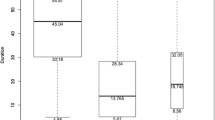Abstract
Life insurance companies are subject to various risks related to universal life products. One such risk-paid-up-arises when policyholders, at some point before maturity, exercise their option to stop paying the periodic premiums initially agreed to for the life of the policy. Here, several predictive models are applied, aimed at anticipating the future state of in-force premium payment policies. This is undertaken in conjunction with balancing techniques, designed to avoid misclassification errors caused by the scarcity of paid-up events in our data. Using the findings from our predictive modeling, we initially identify certain policyholder profiles that seem less likely to paid-up premiums and consequently may be considered as potential targets for underwriting. Additionally, we delve into an essential aspect of policy design: surrender fees. Our analysis highlights a pattern where surrender fees, intended to mitigate surrender risk, may actually exacerbate the risk of policies becoming paid-up under certain circumstances.



Similar content being viewed by others
Data availability
The data utilized in this article is confidential and proprietary, belonging to an insurance company operating within the Spanish insurance market. As such, it is not publicly available or open source.
Notes
As contributions to the SCR are usually the difference between a stressed BEL and the central one, although both depend on several valuation assumptions, such as paid-up probabilities.
References
Breiman, L. 1996. Bagging predictors. Machine Learning 24: 123–40.
Breiman, L. 2001. Random forests. Machine Learning 45 (1): 5–32.
Breiman, L., et al. 1984. Classification and regression trees. Boca Raton: Chapman and Hall/CRC.
Campbell, J., et al. 2014. Modelling of policyholder behaviour for life assurance and annuity products. Schaumburg: Society of Actuaries.
Chawla, N.V., et al. 2002. SMOTE: Synthetic minority over-sampling technique. Journal of Artificial Intelligent Research 16: 321–57.
Chen, T., and C. Guestrin. 2016. Xgboost: a scalable tree boosting system. In: In Proceedings of the 22nd Acm Sigkdd International Conference on Knowledge Discovery and Data Mining, no. 2, 785–794.
Eling, M., and M. Kochanski. 2013. Research on lapse in life insurance: what has been done and what needs to be done? The Journal of Risk Finance 14 (4): 392–413.
Elkan, C. 2001. The foundations of cost-sensitive learning. In: In Proceedings of the Seventeenth International Joint Conference on Artificial Intelligence, 973–978.
Estabrooks, A., T. Jo, and N. Japkowicz. 2004. A multiple resampling method for learning from imbalanced data sets. Computational Intelligence 20 (1): 18–36.
Fier, S.G., and A.P. Liebenberg. 2013. Life insurance lapse behavior. North American Actuarial Journal 2 (17): 153–167.
Friedman, J.H. 2001. Greedy function approximation: A gradient boosting machine. The Annals of Statistics 29 (5): 1189–1232.
Gatzert, N., G. Hoermann, and H. Schmeiser. 2009. The impact of the secondary market on life insurers’ surrender profits. Journal of Risk and Insurance 4 (76): 887–908.
He, H., and E.A. Garcia. 2009. Learning from imbalanced data. IEEE Transactions on Knowledge and Data Engineering 9 (21): 1263–84.
Henriksen, L.F.B., J.W. Nielsen, and M. Steffensen. 2014. Markov chain modeling of policyholder behavior in life insurance and pension. European Actuarial Journey 4: 1–29.
Khan, S.H., et al. 2017. Cost-sensitive learning of deep feature representations from imbalanced data. IEEE Transactions on Neural Networks and Learning Systems 8 (29): 3573–3587.
Kuhn, M. 2008. Building predictive models in R using the caret package. Journal of Statistical Software 28 (5): 1–26.
Ling, C.X., and V.S. Sheng. 2008. Cost-sensitive learning and the class imbalance problem. In Encyclopedia of machine learning, ed. C. Sammut, 231–235. Spring.
López, V., et al. 2013. An insight into classification with imbalanced data: Empirical results and current trends on using data intrinsic characteristics. Information Sciences 250: 113–141.
Maalouf, M., and M. Siddiqi. 2014. Weighted logistic regression for large-scale imbalanced and rare events data. Knowledge-Based Systems 59: 142–148.
Menardi, G., and N. Torelli. 2014. Training and assessing classification rules with imbalanced data. Mining and Knowledge Discovery 1 (28): 92–122.
Ramraj, S., et al. 2016. Experimenting XGBoost algorithm for prediction and classification of different datasets. International Journal of Control Theory and Applications 9 (40): 651–662.
Russell, D.T., et al. 2013. An empirical analysis of life insurance policy surrender activity. Journal of Insurance Issues 36 (1): 35–57.
Seiffert, C. et al. 2007. Mining data with rare events: A case study. In: 19th international conference on tools with artificial intelligence, pp. 132–139.
Smith, M.L. 1982. The life insurance policy as an options package. Journal of Risk and Insurance 49: 583–601.
Sun, Y., A.K. Wong, and M.S. Kamel. 2009. Classification of imbalanced data: A review. International Journal of Pattern Recognition and Artificial Intelligence 4 (23): 687–719.
Thai-Nghe, N., Z. Gantner, and L. Schmidt-Thieme. 2010. Cost-sensitive learning methods for imbalanced data. In: In The 2010 International Joint Conference on Neural Networks (IJCNN), pp. 1–8.
Venables, W.N., and B.D. Ripley. 2002. Modern applied statistics with S. New York: Springer.
Wallace, B. C. et al. 2011. Class Imbalance, Redux. In: IEEE 11th International Conference on Data Mining, pp. 754–763.
Weiss, M. 2004. Mining with rarity. ACM SIGKDD Explorations Newsletter 6 (1): 7–19.
Funding
Funding was provided by Ministerio de Ciencia, Innovación y Universidades (Grant No. PID2019-105986GB-C21), AGAUR of the Catalan Government (Grant Nos. 2020DI9, 2017SGR1147).
Author information
Authors and Affiliations
Corresponding author
Additional information
Publisher's Note
Springer Nature remains neutral with regard to jurisdictional claims in published maps and institutional affiliations.
Rights and permissions
Springer Nature or its licensor (e.g. a society or other partner) holds exclusive rights to this article under a publishing agreement with the author(s) or other rightsholder(s); author self-archiving of the accepted manuscript version of this article is solely governed by the terms of such publishing agreement and applicable law.
About this article
Cite this article
Anaya, D., Bermúdez, L. & Belles-Sampera, J. Modeling paid-ups in life insurance products for risk management. Risk Manag 26, 15 (2024). https://doi.org/10.1057/s41283-024-00146-4
Accepted:
Published:
DOI: https://doi.org/10.1057/s41283-024-00146-4




